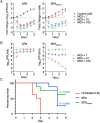Synthetic engineering and biological containment of bacteriophages
- PMID: 36409909
- PMCID: PMC9860248
- DOI: 10.1073/pnas.2206739119
Synthetic engineering and biological containment of bacteriophages
Abstract
The serious threats posed by drug-resistant bacterial infections and recent developments in synthetic biology have fueled a growing interest in genetically engineered phages with therapeutic potential. To date, many investigations on engineered phages have been limited to proof of concept or fundamental studies using phages with relatively small genomes or commercially available "phage display kits". Moreover, safeguards supporting efficient translation for practical use have not been implemented. Here, we developed a cell-free phage engineering and rebooting platform. We successfully assembled natural, designer, and chemically synthesized genomes and rebooted functional phages infecting gram-negative bacteria and acid-fast mycobacteria. Furthermore, we demonstrated the creation of biologically contained phages for the treatment of bacterial infections. These synthetic biocontained phages exhibited similar properties to those of a parent phage against lethal sepsis in vivo. This efficient, flexible, and rational approach will serve to accelerate phage biology studies and can be used for many practical applications, including phage therapy.
Keywords: bacteriophage; biological containment; cell-free genome engineering; phage therapy; synthetic biology.
Conflict of interest statement
S.M. and H.A. filed a patent application. Other authors declare no competing interest.
Figures





Similar articles
-
Cross-genus rebooting of custom-made, synthetic bacteriophage genomes in L-form bacteria.Proc Natl Acad Sci U S A. 2018 Jan 16;115(3):567-572. doi: 10.1073/pnas.1714658115. Epub 2018 Jan 3. Proc Natl Acad Sci U S A. 2018. PMID: 29298913 Free PMC article.
-
Phage-Based Applications in Synthetic Biology.Annu Rev Virol. 2018 Sep 29;5(1):453-476. doi: 10.1146/annurev-virology-092917-043544. Epub 2018 Jul 12. Annu Rev Virol. 2018. PMID: 30001182 Free PMC article. Review.
-
A synthetic biology approach to assemble and reboot clinically relevant Pseudomonas aeruginosa tailed phages.Microbiol Spectr. 2024 Mar 5;12(3):e0289723. doi: 10.1128/spectrum.02897-23. Epub 2024 Jan 31. Microbiol Spectr. 2024. PMID: 38294230 Free PMC article.
-
Phage-Derived Antibacterials: Harnessing the Simplicity, Plasticity, and Diversity of Phages.Viruses. 2019 Mar 18;11(3):268. doi: 10.3390/v11030268. Viruses. 2019. PMID: 30889807 Free PMC article. Review.
-
Genetic Engineering and Rebooting of Bacteriophages in L-Form Bacteria.Methods Mol Biol. 2024;2734:247-259. doi: 10.1007/978-1-0716-3523-0_16. Methods Mol Biol. 2024. PMID: 38066374
Cited by
-
Programming virulent bacteriophages by developing a multiplex genome engineering method.mBio. 2025 Jun 11;16(6):e0358224. doi: 10.1128/mbio.03582-24. Epub 2025 May 23. mBio. 2025. PMID: 40407328 Free PMC article.
-
Precise microbiome engineering using natural and synthetic bacteriophages targeting an artificial bacterial consortium.Front Microbiol. 2024 May 2;15:1403903. doi: 10.3389/fmicb.2024.1403903. eCollection 2024. Front Microbiol. 2024. PMID: 38756723 Free PMC article.
-
Bacteriophage EPP-1, a potential antibiotic alternative for controlling edwardsiellosis caused by Edwardsiella piscicida while mitigating drug-resistant gene dissemination.Sci Rep. 2024 Apr 24;14(1):9399. doi: 10.1038/s41598-024-60214-3. Sci Rep. 2024. PMID: 38658654 Free PMC article.
-
Fitness Trade-Offs between Phage and Antibiotic Sensitivity in Phage-Resistant Variants: Molecular Action and Insights into Clinical Applications for Phage Therapy.Int J Mol Sci. 2023 Oct 26;24(21):15628. doi: 10.3390/ijms242115628. Int J Mol Sci. 2023. PMID: 37958612 Free PMC article. Review.
-
Phage-layer interferometry: a companion diagnostic for phage therapy and a bacterial testing platform.Sci Rep. 2024 Mar 12;14(1):6026. doi: 10.1038/s41598-024-55776-1. Sci Rep. 2024. PMID: 38472239 Free PMC article.
References
Publication types
MeSH terms
LinkOut - more resources
Full Text Sources
Other Literature Sources
Medical
Research Materials

